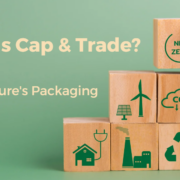What is Cap and Trade?
The wooden pallet and container industry has been promoting the use of wood as an economical and sustainable solution for businesses and their supply chains for years. Our business model is built on recyclable and reusable packaging solutions so that customers can have faith and hard data in the implementation of their sustainability initiatives.
As climate change and greenhouse gas emissions have taken a more prominent place in consumer concerns, governments are implementing new programs and models to incentivize industries to cut emissions that have a detrimental impact on climate and populations around the world. One of the most successful models to accomplish these goals has been “Cap and Trade”.
In this Nature’s Packaging post, we’ll take a quick dive into cap and trade to learn more about it.
What is Cap and Trade?
In order to combat climate change, governments have employed a variety of methods. One such method is cap and trade. Cap and trade is a system in which the government places a limit, or cap, on the amount of pollution that companies can emit. This system would place a limit on greenhouse gas emissions and allow companies to buy and sell allowances for these emissions.
The goal of this system is to reduce emissions gradually over time while giving companies flexibility in how they meet the caps. Companies that exceed their allotted amount must purchase allowances from other companies that have not used up their allotment.
This market-based approach provides an incentive for companies to pollute less, as they can then sell their allowances to other companies. The overall goal of cap and trade is to reduce pollution by setting a limit on emissions and creating a market for buying and selling emissions allowances.
Critics of cap and trade argue that it will lead to higher energy prices and place a burden on businesses. They also argue that it is unfair because it allows some companies to emit more greenhouse gases than others. Supporters of cap and trade argue that it is necessary in order to combat climate change and that it will create incentives for businesses to develop cleaner technologies and implement sustainability processes.
A Short History of Cap And Trade
In the United States, the first mandatory cap-and-trade program was established by the Acid Rain Program of 1990. The program was designed to reduce sulfur dioxide and nitrogen oxide emissions that were causing acid rain. The program was successful in reducing emissions and provided a model for future cap-and-trade programs. According to the EPA, the program was a “pioneering effort” that helped the United States meet its Kyoto Protocol commitment.
In 2012, the Obama administration implemented a cap-and-trade program for greenhouse gas emissions. The program placed a limit on the amount of carbon dioxide that could be emitted by power plants and other large emitters.
The goal of the program was to reduce greenhouse gas emissions by 17% by 2020. However, the program was never fully implemented, and was eventually replaced by other climate change policies.
Despite its challenges, cap and trade remains one of the most popular mechanisms for reducing greenhouse gas emissions. California’s current cap and trade system has been in place for a number of years and is see as a model for future use at a broader level.
How Does Cap and Trade Work?
In order to understand how cap and trade works, it is important to first understand what it is. Cap and trade is a system that was created in order to help reduce greenhouse gas emissions. The way it works is by setting a limit, or cap, on the amount of emissions that a company or country can produce. If they exceed this limit, they must purchase credits from others who have not reached their limit. This provides an incentive for companies to reduce their emissions, as they can then sell their credits to others.
The cap and trade system has been used in the United States since 2009, when the Environmental Protection Agency (EPA) launched the program in an effort to combat climate change. The program has been successful in reducing emissions, but there are still some critics who argue that it does not do enough to address the problem.
The Pros and Cons of Cap and Trade
The cap-and-trade system is a market-based approach to controlling pollution by providing economic incentives for achieving reductions in the emissions of pollutants.
The pros of this system are that it provides a financial incentive for companies to reduce their emissions, and it allows companies to trade emissions allowances with each other. This flexibility means that companies can choose the most cost-effective way to meet their emission reduction targets.
The cons of cap-and-trade are that some argue it may not lead to the level of emission reductions needed to combat climate change, and it could create windfall profits for companies that have already made investments in clean technology.
The Future of Cap and Trade
As the world continues to face the reality of climate change, many countries, industries, and companies are searching for ways to reduce their carbon footprint and implement sustainability into their processes.
The pallet industry continues to explore new areas of their business models to determine where recycling and reuse can fit into a system that rewards lowering greenhouse gas emissions and the ability to sequester carbon.
While we have witnessed the voluntary carbon market slowly rise and gather momentum. It remains relatively misunderstood and somewhat of a black box in terms of value and efficacy.
In the near future, if the pallet industry is able to link custody of certain parts of the sequestration process to recycling that generates a monetary return. Industries and companies will beat a path to the doors faster than you can say, “Wood Is Good”.
Some Great Resources to Explore
Calmatters – The Basics of Cap and Trade
Environmental Defense Fund – How Cap and Trade Works


